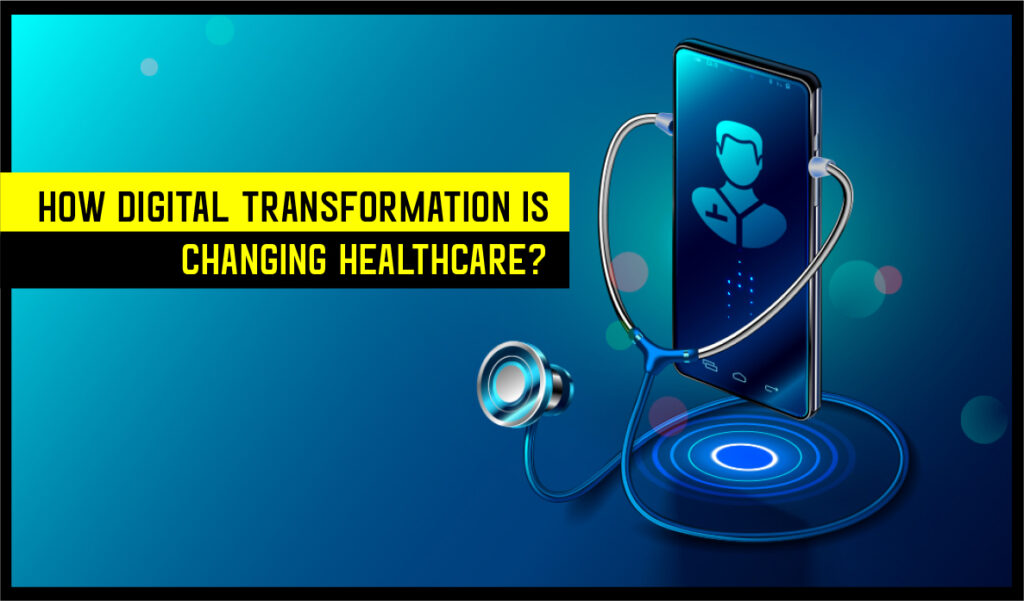In the age of rapid technological advancements, digital transformation has emerged as a catalyst, revolutionizing various sectors across the globe. One such domain that has been profoundly impacted is healthcare.
The integration of digital technologies into healthcare systems has brought about a paradigm shift, transforming the way patients receive care and how healthcare providers deliver it.
From streamlining processes and enhancing patient outcomes to improving accessibility and promoting preventive measures, the impact of digital transformation in healthcare is far-reaching and continues to shape the industry’s future.
In this article, we will go into the remarkable ways in which digital transformation is revolutionizing healthcare. We will explore the innovative technologies and strategies that are reshaping patient care, empowering healthcare professionals, and ultimately leading to better health outcomes.
Contents
- 1 Explore Technology Trends that Drive Healthcare’s Digital Transformation
- 1.1 Telehealth and Remote Patient Monitoring
- 1.2 Artificial Intelligence (AI) and Machine Learning (ML)
- 1.3 Internet of Medical Things (IoMT)
- 1.4 Blockchain Technology
- 1.5 Big Data Analytics
- 1.6 Cloud Computing
- 1.7 Augmented Reality (AR) and Virtual Reality (VR)
- 1.8 Medical Training
- 1.9 Robotics and Automation
- 2 Conclusion
- 3 How Webisoft Helps in Digital Transformation in Healthcare?
- 4 Frequently Asked Questions
Explore Technology Trends that Drive Healthcare’s Digital Transformation
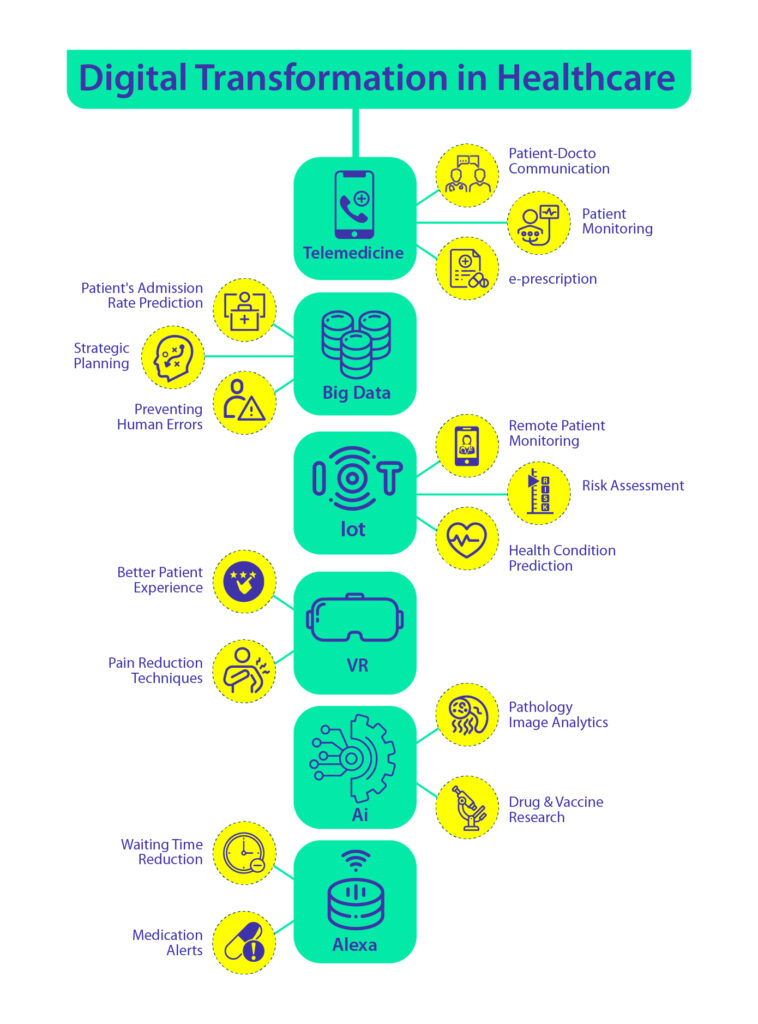
Healthcare’s digital transformation is being driven by several technology trends that have the potential to revolutionize the industry. Here are some key trends that are shaping the digital transformation in healthcare:
Telehealth and Remote Patient Monitoring
Telehealth and remote patient monitoring are transformative technologies that leverage digital platforms and wearable devices to revolutionize the way healthcare services are delivered and patient data is collected.
Telehealth enables patients to access virtual consultations and healthcare services remotely, using video conferencing, phone calls, secure messaging, and mobile applications.
Patients can schedule appointments and have face-to-face consultations with healthcare professionals from the comfort of their own homes or any location with an internet connection.
This not only improves convenience for patients but also eliminates geographical barriers, enabling individuals in rural or underserved areas to access quality healthcare services.
Telehealth also plays a crucial role in providing mental health support by allowing patients to receive therapy and counseling remotely, reducing barriers and improving accessibility to mental healthcare.
Remote patient monitoring takes advantage of wearable devices, sensors, and mobile applications to collect patient data outside of traditional healthcare settings. These devices can track various health parameters, such as heart rate, blood pressure, glucose levels, oxygen saturation, and activity levels.
By continuously monitoring these vital signs and other health indicators, healthcare providers can obtain a comprehensive view of patients’ health conditions, even when they are not physically present in a healthcare facility.
This continuous monitoring allows for early detection of changes or abnormalities in patients’ health status, enabling timely interventions and proactive healthcare management.
The collected data from remote patient monitoring is transmitted in real-time to healthcare providers, who can analyze and interpret the information. This technology enables healthcare professionals to monitor patients’ health conditions remotely, identify trends, and receive alerts or notifications if certain parameters deviate from normal ranges.
Early detection of health issues allows for timely interventions, potentially preventing complications, reducing hospitalizations, and improving patient outcomes.
Additionally, remote patient monitoring is particularly beneficial for managing chronic diseases, as it provides a continuous stream of data that can be used to assess treatment effectiveness, adjust medication dosages, and develop personalized care plans based on each patient’s specific needs.
The integration of telehealth and remote patient monitoring provides a comprehensive and patient-centered approach to healthcare. It allows for virtual consultations and remote access to healthcare services, ensuring continuity of care for patients.
The continuous collection of patient data through wearable devices and sensors facilitates proactive healthcare management, early detection of health issues, and personalized interventions.
These technologies not only improve patient outcomes but also enhance patient engagement, empower individuals to actively participate in their healthcare, and reduce healthcare costs by optimizing resource utilization and preventing unnecessary hospital visits.
Artificial Intelligence (AI) and Machine Learning (ML)
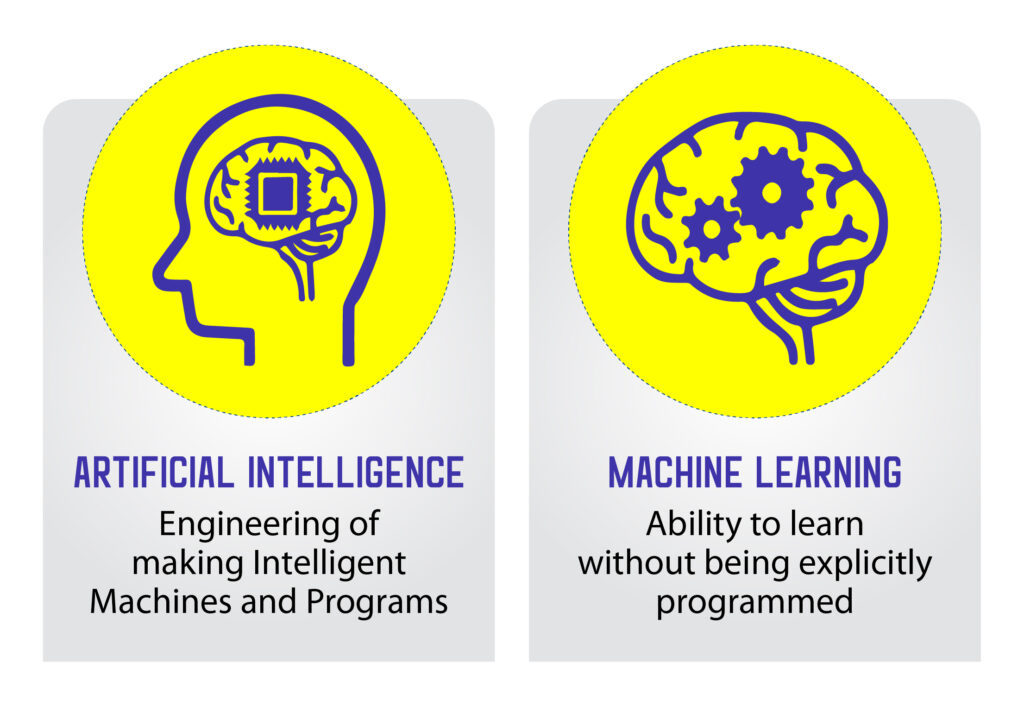
AI (Artificial Intelligence) and ML (Machine Learning) are transformative technologies that have significant applications in healthcare, improving various aspects of diagnosis, treatment planning, and patient care.
These technologies are capable of analyzing vast amounts of patient data, identifying patterns, and generating valuable insights to support healthcare professionals in making informed decisions. Here’s a more detailed explanation:
Diagnosis and Treatment Planning
AI and ML algorithms can analyze electronic health records (EHRs), medical images, lab results, and other relevant data to aid in the diagnosis of diseases and the development of treatment plans.
By comparing patient data with extensive databases and knowledge repositories, AI can help identify patterns and correlations that may not be immediately apparent to human healthcare providers. This can lead to more accurate and timely diagnoses, improved treatment recommendations, and better patient outcomes.
Personalized Medicine
AI and ML techniques enable the development of personalized treatment strategies. By analyzing individual patient data, including genetic information, medical history, lifestyle factors, and treatment outcomes, AI algorithms can generate insights into optimal treatment approaches for specific patients or patient subgroups.
This facilitates precision medicine, where treatment plans are tailored to the unique characteristics and needs of each patient, leading to more effective and targeted interventions.
Patient Monitoring and Care Management
AI and ML algorithms can continuously analyze patient data collected through remote monitoring devices, wearable sensors, and electronic health records. This allows for real-time monitoring of patients’ vital signs, medication adherence, and other relevant parameters.
Healthcare providers can receive alerts and notifications when abnormalities or changes in the data are detected, enabling early intervention and proactive care management.
AI-driven predictive analytics can also help identify patients at higher risk of adverse events or readmissions, enabling targeted interventions to prevent complications and improve outcomes.
AI-powered Chatbots and Virtual Assistants
AI technologies are utilized to develop chatbots and virtual assistants that can interact with patients, answer their questions, and provide basic medical advice.
These virtual agents are available 24/7 and can assist in triaging patient symptoms, providing information on common medical conditions, and offering guidance on when to seek further medical attention.
AI-powered chatbots enhance patient engagement, improve access to information, and reduce the burden on healthcare staff by handling routine inquiries and inquiries.
Medical Research and Drug Development
AI and ML are transforming medical research and drug development processes. These technologies can analyze large-scale datasets, scientific literature, and genomic information to identify potential drug targets, predict drug efficacy, and accelerate the discovery of new treatments.
AI algorithms can also assist in clinical trial design, patient recruitment, and data analysis, improving the efficiency and effectiveness of clinical research.
Internet of Medical Things (IoMT)
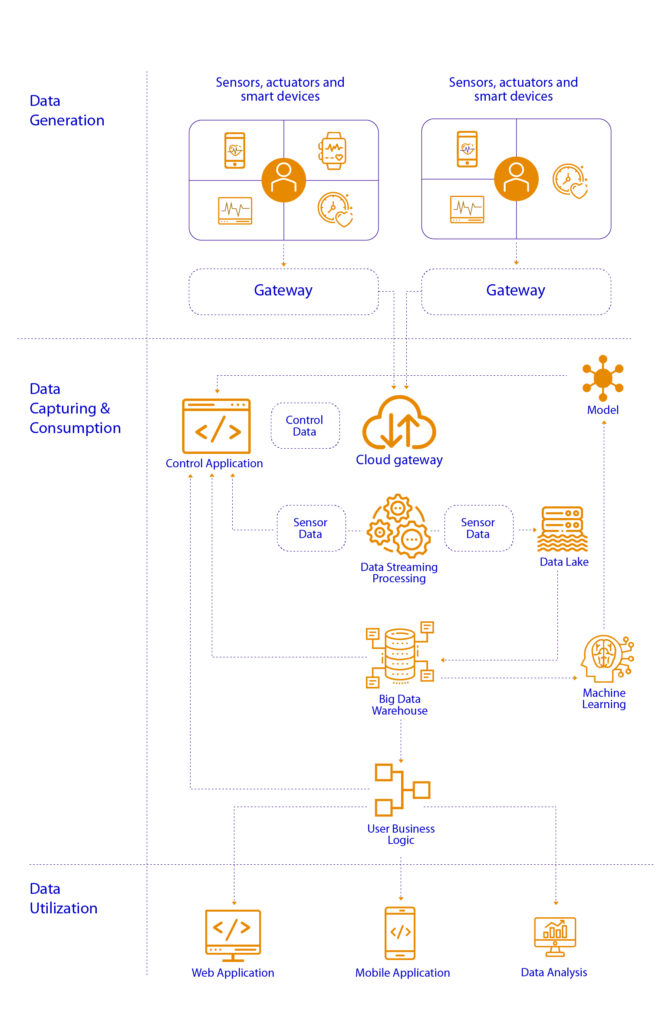
The Internet of Medical Things (IoMT) encompasses a network of interconnected medical devices, wearables, and sensors that gather and transmit healthcare data. This technology enables real-time monitoring, remote patient management, and enhanced healthcare delivery.
IoMT devices are designed to collect a wide range of information, including vital signs, medication adherence, and patient activities, among other data points. Here’s a more detailed elaboration:
Real-time Monitoring
IoMT devices continuously collect data on patients’ vital signs, such as heart rate, blood pressure, temperature, and respiratory rate.
By transmitting this information in real-time to healthcare providers, medical professionals can remotely monitor patients’ health conditions, enabling early detection of abnormalities or changes that may require immediate intervention.
Real-time monitoring allows for timely medical interventions and personalized care management, improving patient outcomes.
Remote Patient Management
IoMT facilitates remote patient management by enabling healthcare providers to monitor patients’ health conditions outside of traditional healthcare settings.
This is particularly beneficial for individuals with chronic diseases, as it allows for continuous tracking of their health status and the effectiveness of their treatment plans.
Healthcare providers can receive updates on patients’ vital signs and medication adherence, enabling proactive adjustments to treatment, personalized interventions, and remote consultations as necessary.
Improved Healthcare Delivery
IoMT devices contribute to improved healthcare delivery by streamlining data collection and enabling efficient and secure transmission of patient information.
The automation and connectivity offered by IoMT reduce the need for manual data entry, minimizing errors and saving time for healthcare professionals.
This allows healthcare providers to have access to accurate and up-to-date patient data, leading to more informed decision-making, improved care coordination, and enhanced patient safety.
Tracking Medication Adherence
IoMT devices can monitor and track patients’ adherence to medication schedules. They can provide reminders and alerts for medication intake, ensuring that patients take their prescribed medications on time.
This feature is particularly valuable for patients with chronic conditions who require strict medication regimens. By promoting medication adherence, IoMT contributes to better treatment outcomes and helps reduce the risks associated with non-compliance.
Patient Activities and Behavior Monitoring
IoMT devices can track patient activities and behaviors, providing insights into lifestyle factors that may impact health outcomes. For example, wearables can monitor physical activity levels, sleep patterns, and dietary habits.
This information can be utilized by healthcare providers to assess overall health, guide patients towards healthier habits, and develop personalized care plans that take into account individual lifestyles.
Blockchain Technology
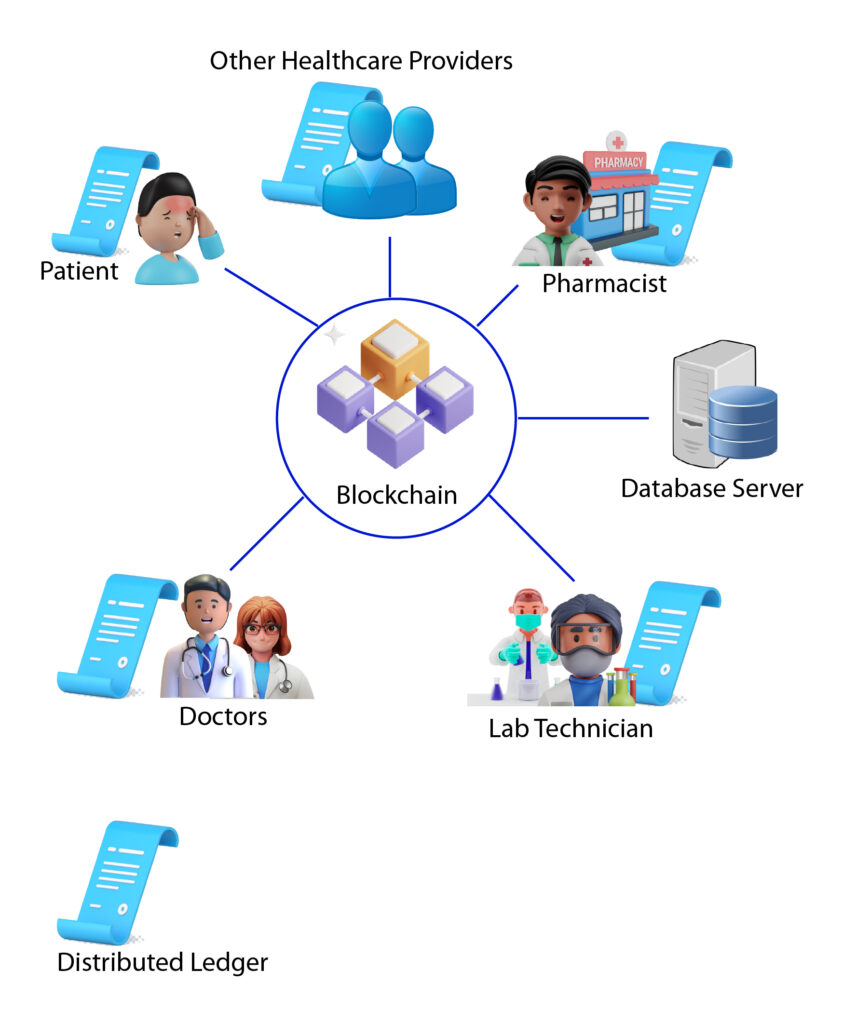
Blockchain technology has emerged as a secure and decentralized platform for storing and sharing healthcare data, offering numerous benefits to the healthcare industry. Let’s delve into a detailed elaboration of its applications:
Secure and Decentralized Data Storage
Blockchain provides a robust and secure method for storing healthcare data. Instead of relying on a central authority or single server, blockchain distributes data across a network of computers (nodes).
Each transaction or data entry is cryptographically secured and linked to the previous one, forming an immutable chain. This ensures data integrity and prevents unauthorized tampering, enhancing the security and trustworthiness of healthcare data.
Enhanced Interoperability
Blockchain enables improved interoperability between different healthcare systems and providers. It offers standardized protocols and smart contracts, which facilitate seamless and secure data exchange between disparate systems.
This enables healthcare providers to access and share patient data across organizations, improving care coordination, reducing duplication of tests, and enhancing patient outcomes.
Secure Sharing of Medical Records
Blockchain allows for secure sharing of medical records between healthcare providers while ensuring patient privacy and consent.
With blockchain, patients have control over their own data and can grant permission to specific healthcare providers or researchers to access their records.
The decentralized nature of blockchain eliminates the need for intermediaries, reducing the risk of data breaches and unauthorized access.
Efficient Management of Pharmaceutical Supply Chains
Blockchain technology can revolutionize the management of pharmaceutical supply chains.
By utilizing blockchain, the entire lifecycle of a pharmaceutical product can be recorded and verified, including the manufacturing, distribution, and sale of medications.
This ensures transparency and traceability, mitigating the risk of counterfeit drugs and improving patient safety.
Secure Clinical Trials
Blockchain has the potential to enhance the security and integrity of clinical trials. It can be used to record and track the entire lifecycle of a clinical trial, including the enrollment of participants, the administration of investigational drugs, and the collection of trial data.
Blockchain’s immutability ensures that trial data remains tamper-proof, providing transparency and trust in the trial process.
Research and Data Integrity
Blockchain technology can support research by providing a secure and transparent platform for sharing and accessing research data.
Researchers can record their findings on the blockchain, ensuring data integrity and establishing an audit trail. This can foster collaboration, reproducibility, and trust within the research community.
Big Data Analytics
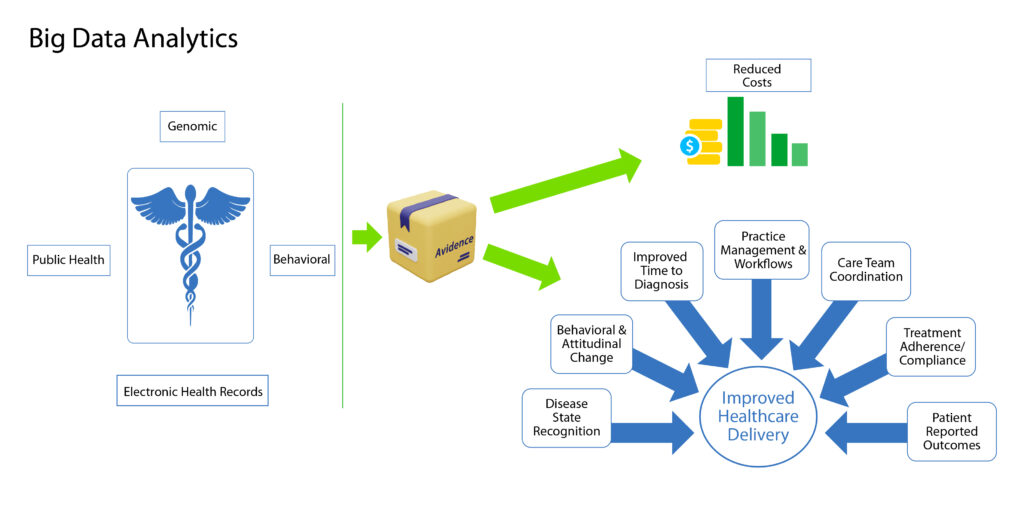
The healthcare industry is a prolific producer of enormous volumes of data, encompassing electronic health records (EHRs), medical imaging, genomic information, and more.
Big data analytics has emerged as a crucial tool for mining and analyzing these vast datasets, enabling healthcare organizations to extract valuable insights, support research endeavors, and enhance clinical decision-making.
Here’s a detailed elaboration of its applications:
Deriving Insights from Large Datasets
Big data analytics enables the extraction of meaningful insights from massive amounts of healthcare data. By applying advanced analytics techniques, such as machine learning and data mining, patterns, trends, and correlations can be identified within the data.
This can unveil critical information about disease prevalence, treatment effectiveness, and patient outcomes, contributing to evidence-based medicine and fostering continuous improvement in healthcare practices.
Supporting Research and Innovation
Big data analytics plays a pivotal role in driving research and innovation in healthcare. Researchers can leverage large datasets to conduct studies, identify new research avenues, and uncover potential breakthroughs.
By analyzing aggregated patient data across diverse populations, researchers can gain valuable insights into disease progression, risk factors, and treatment response.
This fosters the development of new therapies, interventions, and medical advancements, ultimately improving patient care and outcomes.
Improving Clinical Decision-Making
Big data analytics empowers healthcare providers to make more informed and data-driven clinical decisions.
By integrating and analyzing diverse datasets, including patient records, medical imaging, and real-time monitoring data, clinicians can gain a comprehensive view of each patient’s health status.
This enables more accurate diagnoses, personalized treatment plans, and the ability to predict and prevent adverse events. Big data analytics also assists in identifying patterns of treatment response, enabling clinicians to select the most effective interventions for individual patients.
Population Health Management
Big data analytics is instrumental in population health management, which focuses on improving the health outcomes of specific groups or communities.
By aggregating and analyzing data from various sources, such as EHRs, public health databases, and social determinants of health, healthcare organizations can identify health trends, disease hotspots, and areas of intervention.
This facilitates targeted public health initiatives, preventive measures, and resource allocation, leading to more effective population health management and disease prevention strategies.
Predictive Analytics for Disease Prevention
Big data analytics enables predictive modeling and analytics, which aid in identifying individuals at high risk of developing specific diseases. By analyzing large datasets and identifying risk factors, algorithms can generate risk scores or predictive models that estimate an individual’s likelihood of developing a disease.
This facilitates proactive interventions, such as targeted screenings, lifestyle modifications, and early interventions, which can prevent or mitigate the progression of diseases.
Cloud Computing
Cloud computing has emerged as a game-changing technology for healthcare organizations, providing them with scalable and cost-effective storage and computing capabilities. Here’s a more detailed explanation of its applications:
Scalable and Cost-effective Storage
Cloud computing allows healthcare organizations to store and manage vast amounts of data without the need for on-premises infrastructure. Cloud storage solutions offer virtually unlimited capacity, enabling healthcare organizations to scale their storage needs as data volumes grow.
This eliminates the need for costly investments in hardware infrastructure and reduces maintenance and operational expenses. Healthcare providers can securely store electronic health records (EHRs), medical images, research data, and other healthcare-related information in the cloud, ensuring data accessibility, durability, and backup.
Secure Data Storage
Cloud computing providers prioritize data security and offer robust measures to protect healthcare data. They employ encryption, access controls, and advanced security protocols to safeguard sensitive patient information.
Cloud service providers also adhere to stringent regulatory compliance requirements, such as HIPAA (Health Insurance Portability and Accountability Act), ensuring that healthcare organizations can meet data privacy and security standards.
Data Sharing and Collaboration
Cloud computing facilitates secure data sharing and collaboration among healthcare providers. Healthcare organizations can securely share patient records, test results, and other critical information with authorized individuals or entities, enabling seamless collaboration and care coordination.
This promotes efficient and timely decision-making, especially in scenarios where multiple healthcare providers are involved in a patient’s care.
Development and Deployment of Healthcare Applications
Cloud-based platforms provide healthcare organizations with a flexible and scalable environment for the development and deployment of healthcare applications and services.
Software developers can leverage cloud computing resources to build and test healthcare applications without the need for substantial infrastructure investments.
Cloud platforms offer preconfigured environments and tools that streamline application development, deployment, and management, enabling faster time to market for innovative healthcare solutions.
Disaster Recovery and Business Continuity
Cloud computing provides robust disaster recovery and business continuity capabilities for healthcare organizations.
Cloud-based backup and recovery solutions ensure that critical healthcare data and applications are securely backed up and can be quickly restored in the event of a system failure, natural disaster, or other disruptive events.
This helps healthcare providers minimize downtime, maintain continuity of patient care, and meet regulatory requirements.
Flexibility and Scalability
Cloud computing offers healthcare organizations the flexibility to adapt their IT infrastructure to changing needs and requirements. Organizations can scale their computing resources up or down based on demand, ensuring optimal performance and cost efficiency.
This scalability is particularly valuable in situations with fluctuating workloads, such as peak times or when launching new healthcare initiatives.
Augmented Reality (AR) and Virtual Reality (VR)
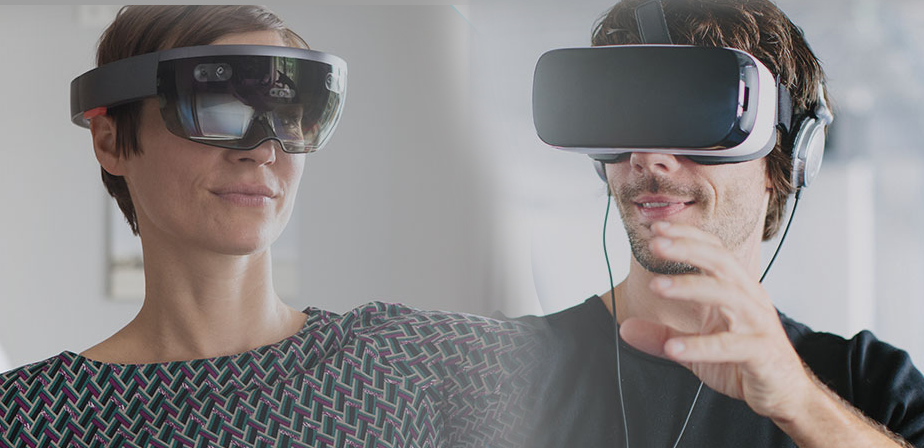
Augmented Reality (AR) and Virtual Reality (VR) have emerged as powerful technologies that have made substantial advancements within the healthcare industry. Their applications in various areas such as medical training, surgical planning, and patient education have proven to be highly valuable and transformative.
Let’s delve into a detailed explanation of how these technologies are being utilized in these specific domains:
Surgical Planning
AR and VR technologies enable surgeons to plan complex procedures with greater precision and accuracy. By integrating patient-specific imaging data, surgeons can visualize internal structures and organs in 3D, enhancing their understanding of the patient’s anatomy.
This virtual visualization helps surgeons anticipate potential challenges, develop surgical strategies, and optimize the surgical approach. Furthermore, AR overlays can be used during surgeries to provide real-time guidance and assistance, improving surgical outcomes.
Patient Education
AR and VR have revolutionized patient education by providing immersive experiences that facilitate an understanding of medical conditions and treatment options. Patients can explore interactive 3D models of their own anatomy, allowing them to grasp complex medical concepts more easily.
For instance, AR can overlay virtual representations of organs or structures on a patient’s body, enabling them to visualize and comprehend their condition. VR can also simulate experiences, such as the effects of medications or surgical outcomes, helping patients make informed decisions and reduce anxiety.
Medical Training
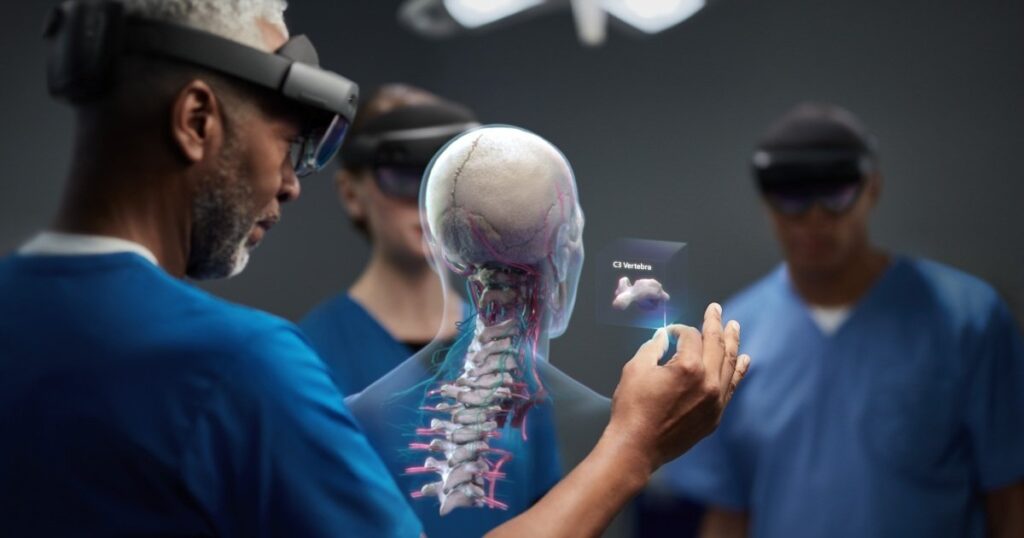
AR and VR offer immersive experiences that can greatly enhance medical training. Medical students and healthcare professionals can use these technologies to simulate medical scenarios, allowing them to practice and refine their skills in a realistic and controlled environment.
Surgical Planning
AR and VR technologies are transforming surgical planning by providing surgeons with enhanced visualization and insights. Surgeons can use these technologies to visualize patient-specific anatomical structures, overlaying them with preoperative imaging data.
This enables surgeons to better understand complex anatomical relationships and plan surgical approaches with precision. By virtually exploring and rehearsing surgical procedures, surgeons can optimize their techniques, reduce risks, and improve surgical outcomes.
Patient Education
AR and VR play a significant role in patient education by providing immersive and interactive experiences. These technologies allow patients to visualize their own anatomy, medical conditions, and treatment options.
By visualizing complex medical concepts, patients can better understand their diagnoses, anticipated outcomes, and the benefits and risks associated with different treatment approaches.
AR and VR experiences can empower patients to make more informed decisions about their healthcare, improve treatment adherence, and enhance overall patient satisfaction.
Rehabilitation and Therapy
AR and VR have demonstrated potential in rehabilitation and therapy settings. These technologies can create engaging and interactive environments to support physical therapy, cognitive rehabilitation, and pain management.
By immersing patients in virtual environments, AR and VR can facilitate movement exercises, cognitive challenges, and relaxation techniques. These immersive experiences can enhance patient motivation, engagement, and outcomes in the rehabilitation process.
Medical Research and Development
AR and VR technologies are also utilized in medical research and development. They enable researchers to visualize and manipulate data in three-dimensional space, facilitating data analysis, visualization of complex models, and identification of patterns or anomalies.
This assists researchers in gaining deeper insights into complex medical phenomena, improving data interpretation, and advancing medical research.
Robotics and Automation
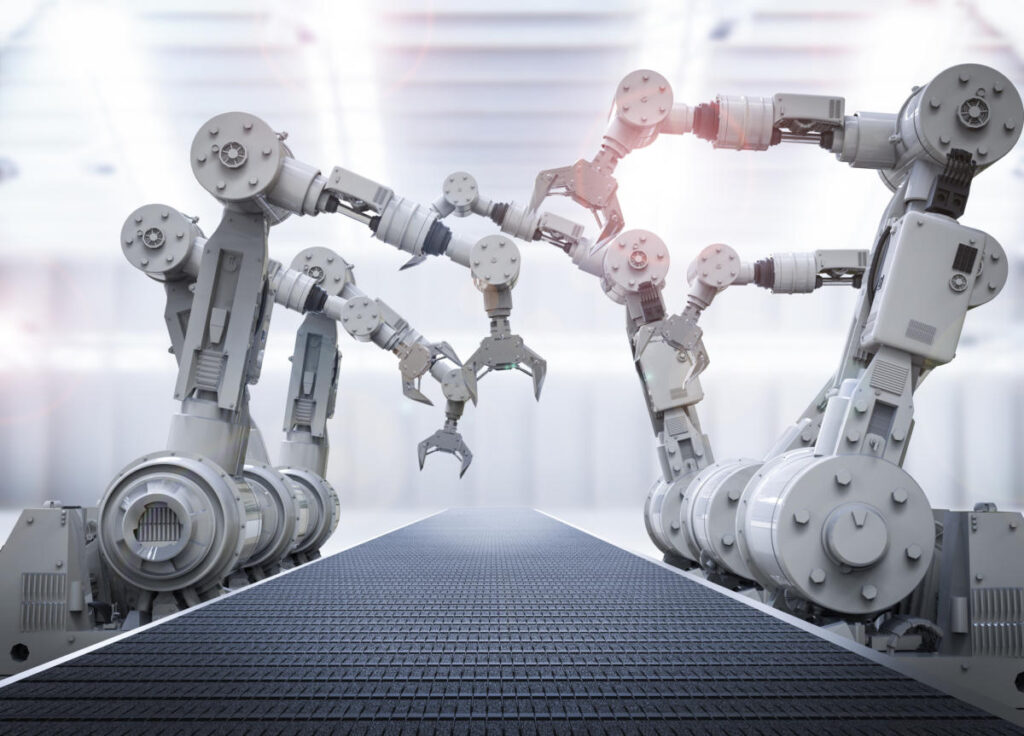
Robotic systems have emerged as valuable tools in the healthcare industry, finding applications in surgical procedures, rehabilitation, and patient care. These robotic systems offer various benefits and advancements in healthcare delivery.
Here’s a detailed elaboration:
Surgical Procedures
Robots are increasingly used to assist in surgical procedures, offering enhanced precision and control. Surgeons can utilize robotic surgical systems to perform minimally invasive surgeries with high accuracy.
These systems often consist of robotic arms equipped with surgical instruments, controlled by surgeons who operate them from a console.
The robotic arms can mimic the movements of the surgeon’s hands, enabling precise maneuvers and reducing the invasiveness of the procedure. Robotic surgery can lead to smaller incisions, reduced blood loss, faster recovery times, and improved surgical outcomes.
Rehabilitation
Robots play a vital role in rehabilitation therapy, assisting patients in regaining mobility and strength. Robotic exoskeletons or robotic limbs can provide support and assistance to individuals with impaired motor functions.
These devices are designed to guide patients through specific movements and exercises, aiding in the rehabilitation process.By providing controlled and repetitive motions, robotic rehabilitation can improve motor function, enhance muscle strength, and promote functional recovery.
Patient Care and Support
Robots are utilized in patient care to provide support and assistance to healthcare professionals. They can perform tasks such as lifting and transferring patients, dispensing medications, and monitoring vital signs.
Robots can reduce the physical strain on healthcare providers and minimize the risk of injuries associated with heavy lifting or repetitive tasks. Additionally, robots can provide companionship and social interaction to patients, especially in settings where human resources may be limited.
Automation of Administrative Tasks
Automation is revolutionizing administrative tasks in healthcare, reducing errors and improving operational efficiency. Robotic process automation (RPA) is being used to streamline repetitive and time-consuming tasks such as data entry, appointment scheduling, billing, and medical coding.
By automating these processes, healthcare organizations can minimize manual errors, improve accuracy, and free up healthcare professionals’ time to focus on patient care. Automation also contributes to increased productivity, cost savings, and faster administrative workflows.
Conclusion
In conclusion, the healthcare industry is going through an incredible transformation thanks to digital advancements.
Technology integration has brought us improved efficiency, better patient care, and easier access to healthcare services. We now have electronic health records, telemedicine, wearable devices, and artificial intelligence revolutionizing the way we deliver and experience healthcare.
These innovations have the potential to enhance outcomes, reduce costs, and empower both healthcare providers and patients. As we continue to embrace this digital transformation, it’s clear that the future of healthcare will be all about increased connectivity, data-driven decision-making, and personalized, patient-centered care.
Ready to experience the power of digital solutions in healthcare? Look no further than Webisoft. Our comprehensive range of services can support your organization’s digital transformation journey. Visit our website now to learn more and embark on a seamless healthcare experience.
How Webisoft Helps in Digital Transformation in Healthcare?
Digital transformation has become a key driver for improving patient care, optimizing operational efficiency, and enhancing healthcare outcomes.
Webisoft, a leading technology solutions provider, has emerged as a trusted partner in empowering healthcare organizations to navigate this transformative journey.
By leveraging its expertise and innovative solutions, Webisoft is pivotal in revolutionizing the healthcare industry through digital advancements.
Webisoft recognizes the criticality of efficient data management and interoperability in healthcare settings. They offer robust solutions that facilitate seamless integration and exchange of information across disparate systems and platforms.
By implementing interoperability standards, such as HL7 and FHIR, Webisoft helps healthcare organizations optimize data accessibility and connectivity. The company enables secure sharing of patient information across different healthcare entities.
Frequently Asked Questions
How has digitization affected healthcare?
Digitalization has transformed healthcare by streamlining administrative tasks, improving access to medical records, enabling telemedicine services, and facilitating remote patient monitoring. It has increased efficiency, communication, and collaboration among healthcare providers, leading to better patient care and outcomes.
What are the benefits of digital transformation in health?
Digital transformation in health brings numerous benefits, including increased accuracy and speed of diagnosis, improved patient engagement through telehealth and mobile health applications, enhanced care coordination among healthcare teams, better data analytics for proactive healthcare management, and cost savings through operational efficiencies.
What is digital transformation in the area of health?
Digital transformation in the area of health refers to the integration of digital technologies, such as electronic health records, telemedicine, wearable devices, artificial intelligence, and data analytics, into healthcare processes. It aims to optimize healthcare delivery, improve patient experiences, and drive better health outcomes through the effective use of technology.
How can digital technologies change hospitals globally?
Digital technologies can revolutionize hospitals globally by enabling remote consultations and telemedicine services, enhancing data-driven decision-making for personalized care, improving operational efficiency through automation and digitization, facilitating the seamless exchange of patient information across healthcare systems, and promoting innovation in healthcare delivery models, ultimately leading to more accessible, efficient, and patient-centric care on a global scale.
